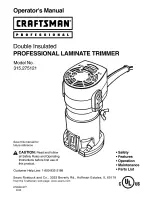
Operating manual
English
9
The service life of the trim line
depends on the following:
– Follow the previous cutting tips,
– for the vegetation which is to be cut,
– where it is cut.
For example, a line wears out
more quickly if it is cutting against
a house wall than around a tree.
Decorative cutting
You will receive a decorative cut
if you cut all vegetation around trees,
posts, fences, etc.
Rotate the whole unit until you are
holding the cutting attachment at an
angle of 30° to the ground (Fig. 19).
Working with the cutting
blade
Before using the unit, place yourself
in the operating position (Fig. 5).
See “Holding the appliance”.
Tips for working with the cutting
blade:
– Cut rhythmically.
– Stand firmly but comfortably
on the ground.
– When cutting, move the upper
part of your body from right to left.
– Rotate the unit in the same direc-
tion in which the blade is cutting.
This promotes cutting.
– Move one or two steps to the next
cutting area after swinging back
the unit and stand firmly again.
Follow these instructions to prevent
vegetation from wrapping itself
around the blade:
– Swing from right to left into the
vegetation which is to be cut
(Fig. 20).
– When swinging back, avoid vege-
tation which has just been cut.
Maintenance
and cleaning
Danger
To protect against injury before
all work on the appliance
– switch off the engine,
– wait until all rotating parts have
come to a standstill,
– pull out the mains plug,
– leave motor to cool down
(approx. 30 minutes).
Have all repairs carried out
by a repair shop only.
At the end of the season have
the unit inspected and serviced
by a specialist company.
Do not splash the unit with water,
otherwise electric components
may be damaged.
Clean the appliance after every
use. Failure to clean the appli-
ance can damage the materials
and cause malfunctions.
Changing the trim line
Always use a trim line with a dia-
meter of 1,6 mm (max.).
If a thicker trim line is used,
the motor may overheat or fail.
There are two methods of replacing
the trim line:
– Winding a new line onto the spool
– Fitting a coil with a prewound line
Winding a new line onto the spool
Fig. 21
Hold spool housing (1) and loosen
the bump knob (2) clockwise and
unscrew.
Take out empty line spool (3) and
spring (4).
Clean spool housing (1), spring (4),
line spool (3) and bump knob (2).
Fig. 22
Remove dirt from between
spool housing (1) and retaining
washer (5).
Check the toothing (6) for wear
on he spool housing (1) and
on the line spool (3).
If required, replace damaged
parts.
Provide 2 new 3-metre long trim
lines.
Note
Always use the specified line length!
The line may not be released
correctly if it is too long.
Fig. 23
Insert one end of each line into
the bores in the lower and upper
spool half.
Wind the lines in tight, even layers
onto the lower and upper halves
of the spool. Observe the winding
direction indicated on the spool!
Fig. 24
Press the line ends (approx.
15 cm) into the two opposing
retaining slots (1.6 mm mark).
Fig. 25
Insert the line spool with spring
into the spool housing. Guide the
line ends through the opposing
openings in the spool housing.
Pull on the line ends to release
the lines from the retaining slots.
Fig. 26
Press line spool all the way into
the spool housing and hold.
Screw on bump knob anti-clock-
wise and tighten by hand while
holding the spool housing.
Fitting a coil with a prewound line
Fig. 21
Hold spool housing (1) and loosen
the bump knob (2) clockwise and
unscrew.
Take out empty line spool (3) and
spring (4).
Clean spool housing (1), spring (4)
and bump knob (2).
Fig. 27
Remove dirt from between
spool housing (1) and retaining
washer (5).
Check the toothing (6) for wear
on the spool housing (1).
If required, replace spool housing.
Fig. 24
Pull the line ends of the new line
spool out of the two opposing
retaining slots. Unwind the line
by approx. 15 cm and press
it back into the retaining slot
(1.6 mm mark).
Insert the spring into the new line
spool (Fig. 28).
Fig. 25
Insert the line spool with spring
into the spool housing. Guide the
line ends through the opposing
openings in the spool housing.
Pull on the line ends to release
the lines from the retaining slots.
Fig. 26
Press line spool all the way into
the spool housing and hold.
Screw on bump knob anti-clock-
wise and tighten by hand while
holding the spool housing.
!














































